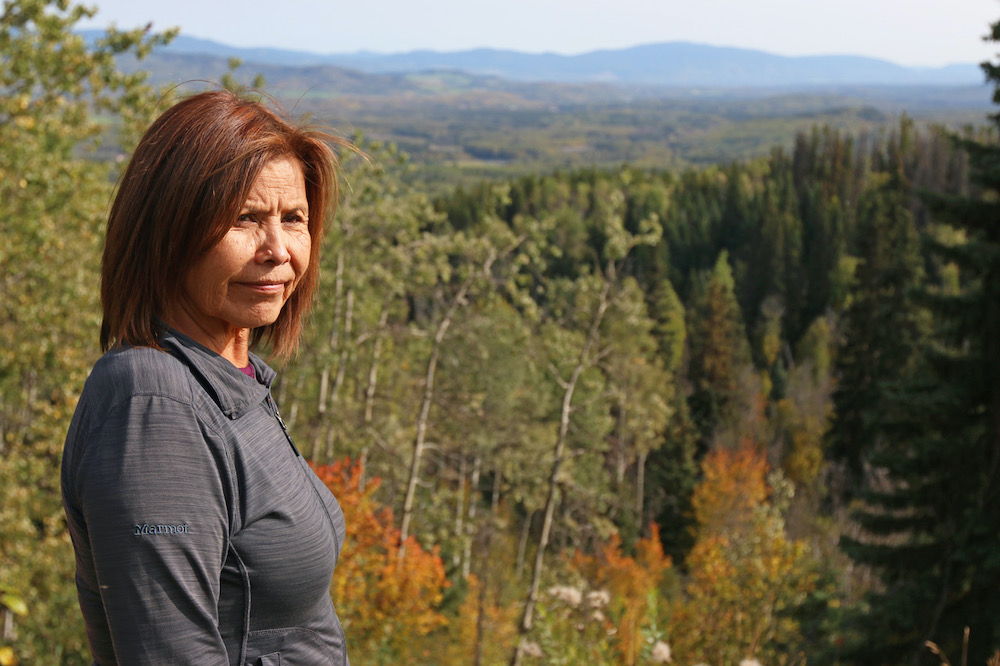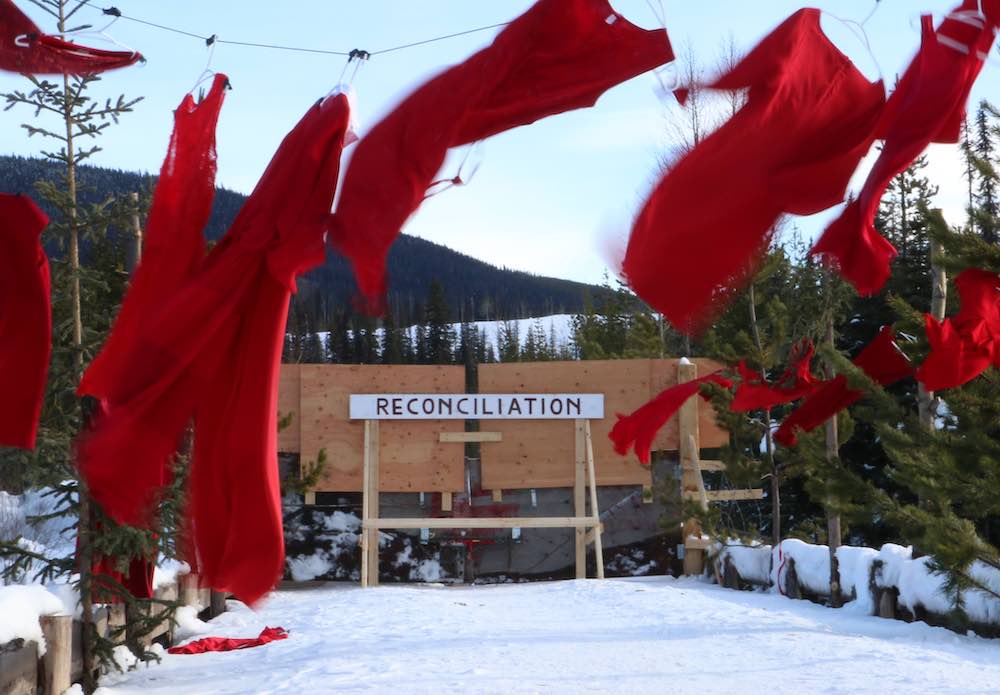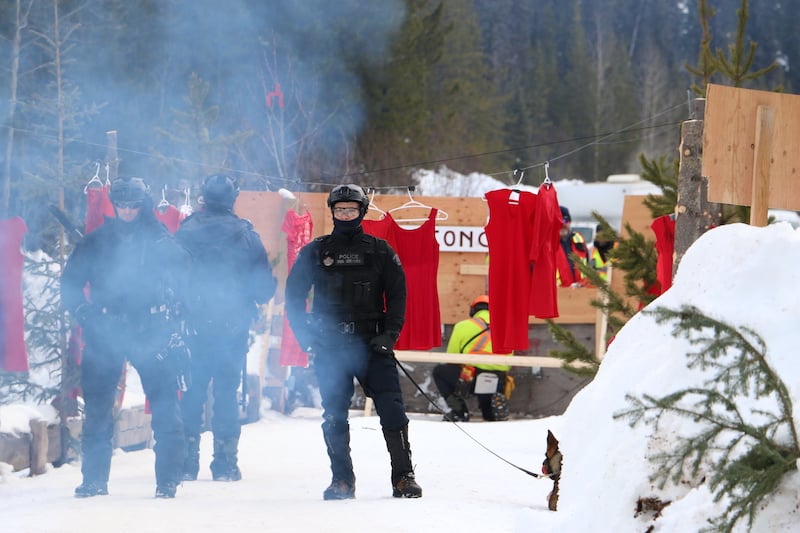Canada’s national police service can’t — or won’t — reveal what it spends investigating cases of missing and murdered Indigenous women and girls, despite a national inquiry’s conclusion that violence against Indigenous women is “deliberate race, identity and gender-based genocide.”
This week marks one year since The Tyee asked the RCMP, through a freedom of information request, how much it spent over the previous year investigating unresolved cases of missing and murdered Indigenous women and girls.
It has never provided a response, despite a complaint to the Office of the Information Commissioner.
Advocates say the RCMP’s lack of transparency on efforts to protect Indigenous women is matched by its failure to communicate with families affected by the murders and disappearances.
Sue Brown, director of legal advocacy and policy for Justice for Girls, said building trust through transparency is critical to reconciliation and required to address the Truth and Reconciliation Commission’s Calls to Action and the recommendations of the National Inquiry into Missing and Murdered Indigenous Women and Girls.
“Being transparent about the work that they’re doing to investigate these cases would be the bare minimum that they would need to be doing in response to the recommendations from the MMIWG commission,” Brown says.
“That is at the heart of why this got to genocidal proportions in the first place, is that they were failing to properly investigate and protect Indigenous women and girls.”
The Vancouver-based non-profit advocates for at-risk teenage girls, including working with the families of murdered and missing Indigenous girls. Brown says it’s common for families to feel they’re not getting the information they need from police, sometimes leaving grieving loved ones to take on the role of investigators.
“I think having more free-flowing information to families, as well as to communities more generally, on this broader level, is just a bare minimum of what they need to do to build that trust,” Brown says.
Gladys Radek’s family has been searching for information about her niece, Tamara Chipman, for over 15 years. Chipman was 22 when she was last seen attempting to hitchhike from Prince Rupert to her home in Terrace on Sept. 21, 2005.
Radek says her brother, Tamara’s father, hasn’t heard from police in years and has stopped trying to get answers. He believes police don’t care about his missing daughter, she says.
“That breaks my heart when my brother says that,” Radek says. “It’s a true reality, but it still breaks my heart to hear it.”
The stretch of Highway 16 between Prince Rupert and Prince George has become known as the Highway of Tears for its disproportionate number of missing and murdered women. Radek, who lives in Terrace, has become an advocate for the families grieving lost loved ones in the region.
“I had no idea until Tamara went missing how big it really was, until the other families started coming to me and telling me their stories,” she says.
Radek was a member of the National Family Advisory Circle, which provided advice to the National Inquiry into Murdered and Missing Indigenous Women and Girls. The inquiry spent three years hearing from families nationwide who had lost loved ones. It made a Smithers stop in September 2017.
Nearly two years after the commission released its final report, its 231 calls for justice — including the need for more responsive, transparent and accountable policing when it comes to investigations and oversight — have not been implemented. The federal government said in December that it’s working on a “national action plan” to respond to the inquiry’s recommendations.
Last spring, on the one-year anniversary of the commission’s report, the RCMP released a statement reaffirming its commitment to improving relations with Indigenous communities and saying it is contributing to the national plan.
The commission’s 2017 stop in Smithers was the last time Radek’s family met with police, she says.
“About two weeks before the inquiry in Smithers, then they decided that they were going to come and see us and they basically told us then that, ‘We know that Tamara’s dead, but we don’t know where she is,’” Radek remembers.
She said Project E-Pana, a task force established to investigate missing and murdered women, is “useless.”
The RCMP have several task forces nationwide dedicated to solving missing persons cases.
E-Pana was created in 2006 to investigate cases of murdered and missing Indigenous women along the Highway of Tears but was later expanded to include other northern highways. It only investigates historical cases, ranging from 1969 to 2006.
Project KARE was established in 2003 to investigate cases of people missing in the Edmonton area. It has since expanded to add the Pro-Active Team, which addresses prevention measures like education and harm reduction. Though it began as a joint effort between the RCMP and Edmonton police, the city has since moved its officers back to its historical homicide unit.
Likewise, Project Devote in Winnipeg was originally a partnership with the Winnipeg Police Service, employing eight Winnipeg police officers and 12 people from the RCMP. Last year, Winnipeg police pulled officers from Project Devote, noting that only one of 30 cases had been solved.
Project Evenhanded, which began in 2001 to investigate the disappearance of women in Vancouver’s Downtown Eastside, wound down following the arrest of Robert Pickton. Women like Chelsea Poorman, who disappeared in September, continue to go missing from the neighbourhood.
Wayne Clary is a former investigator with Project Evenhanded who began working with Project E-Pana in 2012. Though retired, he’s remained with the program to handle the flow of information.
He says he expects E-Pana will eventually wind down as well.
“Not for the foreseeable future,” he adds. “Of course, I’d like to see it end with charges on all the files. Whether that happens or not, I don’t know.”
When the project started, the team was investigating 13 murder cases and five missing women cases. As it ramped up, it employed close to 70 people, Clary says.
Since then, it has been “financially decimated,” according to a 2014 report in the Vancouver Sun. Once funded at $5 million, just $800,000 was allotted to E-Pana in 2013-2014, the Sun reported. At that time, the task force had 12 investigators.
Today, Clary says, E-Pana has six to eight full-time staff. While declining to give a number, he says E-Pana’s budget is covered through B.C.’s Major Crimes Unit and is largely personnel costs, in addition to enough funding to cover any travel.
The unit works out of the major crimes office in the RCMP’s Surrey head office for B.C., he said, and support can be pulled from other departments as needed.
“Whenever we have to travel, there’s no issue with that, or if we get into different types of more complicated investigations, there’s money for that,” he says. “It’s a nice luxury to have as compared to a small detachment.”
In the 15 years it has been running, E-Pana has arrested Garry Handlen, who was convicted in 2019 of first-degree murder in the case of Monica Jack. The 12-year-old disappeared while riding her bike near Merritt in 1978.
Investigators say they have also identified the killer of Colleen MacMillen, who was 16 when she disappeared in 1974. DNA linked Bobby Jack Fowler, a convicted sex offender who died in a U.S. prison in 2006, to her murder. Fowler is suspected in the murders of several other northern B.C. women.

Many murders and disappearances remain unresolved. Exactly how many is almost as hard to pin down as the funds spent on solving them.
A Highway of Tears symposium in 2006 identified nine cases of murdered or missing Indigenous women in the north, including Tamara Chipman. A year later, that number grew to 18 and the project’s scope expanded to include two additional northern highways.
By 2008, Radek says she was aware of 44 unsolved murders or disappearances of Indigenous women on northern highways. Since then, several more have gone missing or been found murdered, bringing the total to about 50, she says.
In its most recent update, the RCMP cites 2014 data in determining that Indigenous women and girls are “over-represented among missing and murdered women in Canada.”
The 2014 report found 164 cases of missing Indigenous women and girls and 1,017 homicides between 1980 and 2012. The RCMP said almost 90 per cent of homicides of Indigenous women and girls are solved.
In a 2015 update, the RCMP said there were 185 missing Indigenous females nationwide, representing about 10 per cent of total missing women and girls.
Lorraine Whitman, president of the Native Women’s Association of Canada, questions the data’s accuracy.
“I truly believe that there’s far more numbers than what has been recorded,” she says. “We know there’s thousands more that have gone missing. We’re hearing it from the families, and it’s not properly documented.”
Whitman believes that RCMP transparency about the resources it invests into investigating and solving these cases might discourage those who prey on Indigenous women.
“This may make the perpetrators think twice about committing violence against Indigenous women and girls, if they know that the crimes were being taken seriously,” she says. “The only way we could build the trust is work together and see something coming out of it through transparency, letting them know that… they are working on these cases and how many cases they are working on.”
The RCMP appears to have no dedicated budget for addressing the recommendations of the national inquiry, which were discussed at the 2020 House of Commons Standing Committee on Public Safety and National Security.
Unlike other law enforcement issues, like First Nations policing and human trafficking, the report recommendations did not warrant a separate line item in the RCMP’s 2020 budget.
“The final report is highly critical of law enforcement generally, and the RCMP in particular,” the RCMP says in its “hot issues” notes for the committee. “Key to the criticisms are allegations of various forms of discrimination and indifference, poor family and community communications and a lack of action on major cases involving Indigenous victims, including human trafficking.”
But the RCMP says there are no financial implications to the issue.
“The RCMP is not seeking funding in Budget 2020 for MMIWG-related activities,” it says.

The allocation of resources within the force is evidence of systemic racism, say advocates like Brown, who points to millions spent policing the Morice West Forest Service Road on Wet’suwet’en territory while cases of missing and murdered women in the region remain unresolved.
The remote resource road was the location of RCMP actions in January 2019 and February 2020 as police removed Indigenous land defenders and supporters from the region and dismantled roadblocks preventing the construction of Coastal GasLink pipeline. In early 2019, a remote detachment known as the Community-Industry Safety Office was established on the Morice.
The Tyee submitted freedom of information requests for a summary of resources spent policing the Morice road area at the same time we requested an accounting of funds spent investigating cases of murdered and missing Indigenous women.
Seven months after making that request, and after a complaint to the Office of the Information Commissioner, RCMP released the information.
In the last three months of fiscal year ending March 31, 2019, the RCMP spent more than $3.6 million on Coastal GasLink-related policing. Between April 1, 2019, and March 31, 2020, it spent nearly $9.5 million.
In total, the RCMP had spent more than $13 million policing the Morice forestry road between Jan. 1, 2019, and March 31, 2020. Patrols continue today.
Much of the total, almost $6.5 million, was spent on personnel. RCMP have declined to say how many officers are working in the area, but Wet’suwet’en hereditary chiefs have in the past said there were the equivalent of 16 full-time officers.
Meanwhile, families like Radek’s continue to wait for information about their loved ones.
“I think I’ve come to accept that she’s dead, just judging from the stories that I’ve heard, and we believe that we know who’s responsible, but we can’t prove it,” she says.
“There’s so much undone here. I feel like we’re just talking to a brick wall.”
In an emailed statement, the RCMP’s national media relations office said that since the missing and murdered Indigenous women’s inquiry released its final report, the force has taken action to attract Indigenous applicants and consult with leaders and Elders. It has also introduced mandatory trauma-informed and cultural awareness trainings.
It added that it has been working on improving communication with families and implementing new initiatives relating to missing persons investigations.
“Violence against Indigenous women, girls, Two Spirit and LGBTQQIA+ people in Canada is an ongoing national tragedy,” the statement said. “The RCMP is committed to improving relationships with Indigenous communities, supporting survivors and families, and ensuring that investigations are robust, professional and result in justice for victims and their families.”
In addition, the RCMP said it is working to build trust.
It directed The Tyee back to its Access to Information and Privacy Branch for an update on the freedom of information request.
Last week, an investigator with the Office of the Information Commissioner of Canada assigned to The Tyee’s complaint against the RCMP said the force is waiting on additional information to process the request and that it may be able to complete the request “in the next several weeks.” ![]()
Read more: Indigenous, Rights + Justice
















Tyee Commenting Guidelines
Comments that violate guidelines risk being deleted, and violations may result in a temporary or permanent user ban. Maintain the spirit of good conversation to stay in the discussion.
*Please note The Tyee is not a forum for spreading misinformation about COVID-19, denying its existence or minimizing its risk to public health.
Do:
Do not: